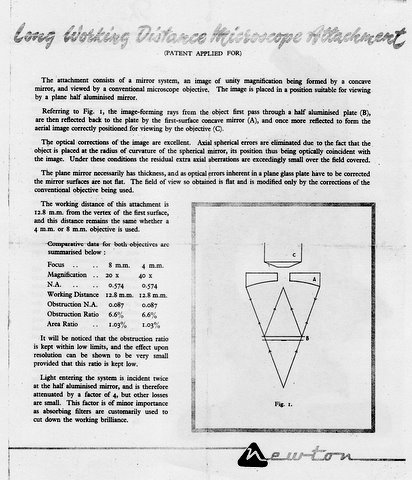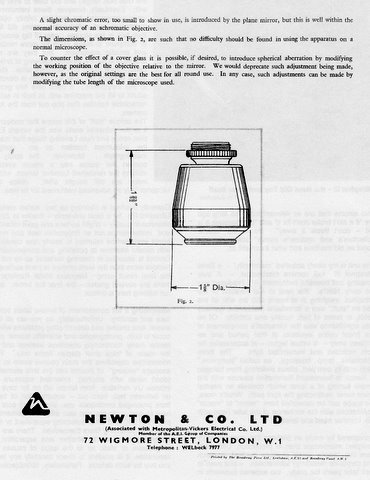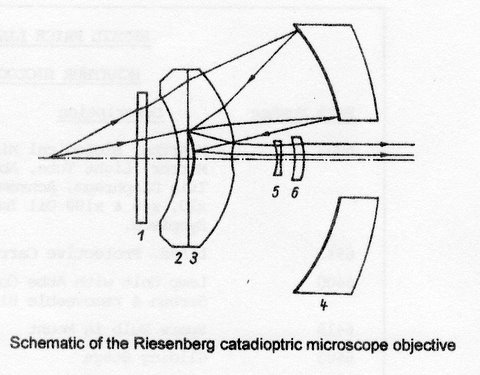

A Most Remarkable Objectiveby Fritz Schulze, Canada |
About 8 years ago a most remarkable objective came into my possession. At first glance I thought it was a reflecting type of objective but on closer examination it turned out to be a catadioptric system where the image is formed by both a mirror system and a lens system, the purpose being to achieve a long working distance. The brochure of the manufacturer, Newton & Co. Ltd., London, is self explanatory. I would like to add a few comments, though.
The objective I have is the 40x. It contains a Beck London 4mm objective. When I tried it out on my Zeiss Photomicroscope I using a stage micrometer as a test object I found the image more than disappointing. The field stop had to be exactly the size of the field of view or the image degraded beyond usefulness, actually almost disappeared. I then noticed that the inner tube of the mirror system was blank aluminum. After I painted it flat black, the image improved considerably. I also had to close the condenser aperture diaphragm by half in order to avoid a double image.. Still, the contrast left a lot to be desired.
The manufacturer’s claim that the image is non-inverted, thus facilitating any manipulation of the specimen, turned out to be a disadvantage on my Photomicroscope which already yielded a non-inverted image. Hence, the image with the Newton objective was inverted after all!
Another claim, that this objective “works very well under phase-contrast conditions” ( a peculiar way of wording), is also puzzling. Although in principle a phase-contrast objective could be substituted, it would require considerable alterations and adjustment beyond the scope of a normal user. I could, though, see the condenser phase rings clearly with the auxiliary microscope, confirming their claim that phase-contrast is possible.
The semitransparent plane mirror plate did not seem to be “half-aluminized”, perhaps 25% as it appeared, but I did not actually measure the reflectivity. The central frosted 2mm diameter disk on the outer surface serves probably to eliminate a secondary reflection from a critical surface.
The manufacturer is no longer in existence. Research on the Internet yielded the following information:
J. Newton’s signature appeared on October 26, 1704 (a year before his relation Sir Isaac Newton was knighted) as a maker of scientific instruments, mostly globes. Thus it existed in the early years of Queen Anne and can claim to be the oldest scientific company in the world.
In 1914 they were listed as manufacturers of optical and scientific instruments. In 1947 they exhibited at the British Industrial Fair. By then they were associated with Metropolitan-Vickers Electrical Co. Ltd which became later the Vickers Electrical Co. (Part of AEI).
(See www.earlyphotography.co.uk) I can, therefore, date this objective as approximately from the early post WW II years.
The actual correction of the image in the Newton System is achieved by the conventional “refractive” Beck objective. There is, however, a drawback to this kind of catadioptric system.
Contrary to common belief mirror objectives are generally inferior to lens objectives even if most carefully computed and manufactured. One of the reasons is the loss of central rays which causes a strong deformation of the diffraction (Airy) disc and, therefore, a noticeable loss of image quality. Secondly, in order to obtain a comparable correction the mirror surface has to be manufactured several orders more precisely than corresponding lens surfaces. Residual aberrations are much more disturbing.
In 1964 Riesenberg* (VEB Carl Zeiss Jena) developed a catadioptric microscope objective with a long working distance. The planapochromatic mirror objective 40/0.50 offered a free working distance of 17mm and was to be used with a non-corrective eyepiece. The large lens component 2 3 with integral convex mirror played an important role in flattening the image. The plane-parallel quartz glass plate 1 is part of the optical system. Its thickness and right angle to the optical axis are most critical. Judging by the design, the cost of this objective must have been rather high.
In the Newton system a 1:1 image created by the combination of the concave mirror and the semi-transparent plane glass plate is observed through the conventional microscope objective. Any imaging errors due to imperfection of the mirror arrangement are magnified by that objective. A slight deviation of the 90º angle to the optical axis of the glass plate may be one of the causes of the unsatisfactory image quality I observed.
The Newton long working distance objective may not be an outstanding optical system but it is a rare and unusual addition to my collection. I would welcome to hear from anyone who can supply additional information on this subject.
All comments to the author Fritz Schulze are welcomed.
* H. Beyer, Handbuch der Mikroskopie, VEB Verlag Technik Berlin,1973





The planapochromatic mirror objective 40/0.50 in working position on the JENA Lasermikro-analysator LMA 10. The second objective is a Planachromat L 16/0.20 with a working distance of 15.5mm.
Microscopy UK Front
Page
Micscape
Magazine
Article
Library
Please report any Web problems or offer general comments to the Micscape Editor .
Micscape is the on-line monthly magazine of the Microscopy UK website at Microscopy-UK .